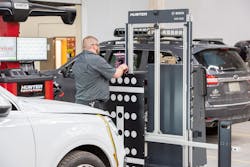Assign the right skill set for ADAS repairs
Content brought to you by Auto Body Repair Network. To subscribe, click here.
A lot has changed over the last few years in vehicle design with Advanced Driver Assistance Systems (ADAS) being more prominent and the number of system components increasing. I’ve discovered just how much has changed through discussions with several OEMs and my friends at I-CAR, including the training needed to properly diagnose and calibrate ADAS. While most are identifying a mechanical skill set to handle system repairs, I have learned through these discussions that there is a higher knowledge requirement to perform these tasks.
When reviewing I-CAR’s definition for their mechanical skill set, you’ll find it doesn’t mention ADAS systems:
“A mechanical technician diagnoses and repairs collision-related mechanical damage including – but not limited to – steering, suspension, air conditioning, engine, brake, restraint, and electrical systems. The technician uses measuring and alignment equipment to diagnose damage and return front and rear wheel alignments to manufacturer’s specifications. Hand and power tools are used to remove or repair damaged parts and proper install new parts.”
However, when you look at their electrical/diagnostic skill set, you see that it provides the training required to perform ADAS repairs and calibrations:
“An electrical/diagnostics technician follows OEM information for scanning and calibration during the collision repair process. The technician may perform a Pre-Repair Scan/Health Scan to capture codes, a Post-Repair Scan to identify and clear codes, and/or a Post-Repair Calibration/Initialization following the removal, installation, and/or repair of many safety and driver convenience system parts, or if there is damage to the mounting location(s), R&I or R&R of the cameras/sensors/mounting locations, R&I or R&R of parts in front of, or behind, cameras and/or sensors, or R&I or R&R of closure/trim panels.”
To follow suit, the estimating system providers have included labor rate categories for diagnostic and electrical. These labor rate categories do more than specify the rate for a particular repair process: they also identify the recommended skill set to be assigned to the repair. Identifying the proper skill set during the damage appraisal process helps to ensure the right technician is assigned to the repair during repair planning.
While assigning work based on skill sets might be new to you, it is something we all need to consider when planning a collision repair. The complexity of today’s vehicles is changing rapidly and the days of assigning a repair to your “A” tech who would handle the complete repair are gone. Understanding that you would not assign a Body (non-structural) technician to replace inner structure, the same reasoning would apply when you consider assigning a Mechanical technician to complete an ADAS calibration. The ADAS repair processes are just as defined as structural repairs and assigning the correct skill set is critical to having the task completed properly. Adding a (D) or (E) to the labor type when creating your damage appraisal will help ensure the right skill set is assigned to the repair.
As we start breaking down repairs by skill sets, I believe we will realize that collision repairs are getting more segmented and specialized. Educating your people today on the value of assigning the individual to a repair that possesses the proper skill set will help sustain your business as vehicles become more complex. I discussed this in my September 2020 ABRN article "Increase reimbursements by managing skill sets" and in my May 2018 article, "Improving your effective labor rate." In both articles, I discussed improving profits and the additional importance of assigning the right person to each task. The most effective way to do that is by using the proper labor categories based on the skill required. This will help set your business up for success and prepare your team for the changes in safety features we continue to see in vehicle designs today and in the future.
Read the article? Get AMI credits!
This article is worth .25 credit hours toward Automotive Management Institute (AMi) designation programs. To receive credit, log in or set up a free “myAMi” account at ami.knowledgeanywhere.com. Then search for "Assigning the right skill set for ADAS repairs" to get to the quiz.
About the Author
John Shoemaker
John Shoemaker is a business development manager for BASF North America Automotive Refinish Division and the former owner of JSE Consulting. He began his career in the automotive repair industry in 1973. He has been a technician, vehicle maintenance manager and management system analyst while serving in the U.S. Air Force. In the civilian sector he has managed several dealership collision centers, was a dealership service director and was a consultant to management system providers as an implementation specialist. John has completed I-CAR training and holds ASE certifications in estimating and repair. Connect with Shoemaker on LinkedIn.

